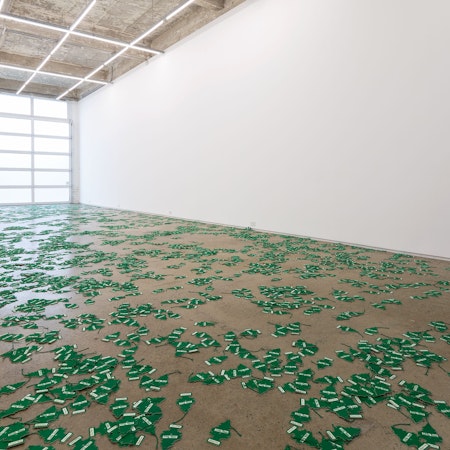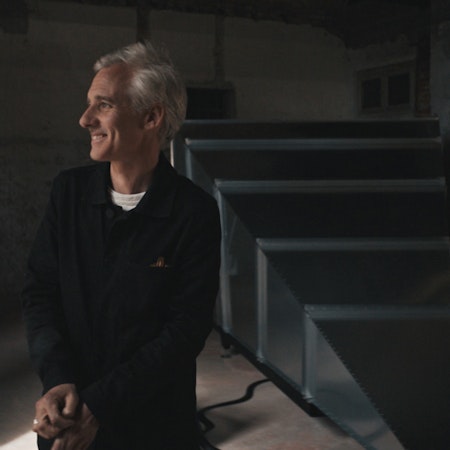Growing up in Southern California, I spent an extraordinary amount of time in cars: twenty minutes to the store, a half hour to high school or the movie theater. Outside the car, the air might be filled with smog and diesel fumes; inside, the incongruous but pleasant scent of Royal Pine. Little Trees held up the experience of the car as a bubble sealed off from the air outside, cushioned from the consequences of its own fuel combustion. Inside the car, your senses were transported to a non-place1; you could smell something like pine trees even when surrounded by auto exhaust in a semi-arid climate.
Dane Mitchell’s An Unbroken Surface shatters—and scatters—this fantasy of the car as an air-conditioned cocoon. Like the flower-strewn floors of enfleurage fragrance factories and the early scatter pieces of Robert Morris, it refuses monumentality, inviting us into an installation that has to be physically traversed on foot. Like a ramble through the woods—or through a miniature fallen forest of Little Trees—An Unbroken Surface is immersive, diffuse, and filled with shifting perspectives.
As visually striking as these thousands of fallen, disposable trees might be, the work’s most distinctive component is invisible: the scented air as a dispersed, volatile, and unrelenting sculptural form. The synthetic, piney scent of air fresheners presents another sculptural component—an essential one, given Mitchell’s longstanding interests in scent and invisible forces. Within the gallery, the cloying scent of chemical pine comprises an ‘inescapable ecology’—a ‘trans-corporeal’ substance that not only surrounds visitors, but enters their breath and insinuates itself into their bodily biochemistries.2 For different breathers, it might trigger nostalgic memories of long, scented drives and hikes in the woods, pleasant associations linked to ideas of wilderness and fresh air, or symptoms of chemical sensitivity—or all of these at the same time.
But what, precisely, are these Little Trees and their Royal Pine scent, and what are they doing in Naarm Melbourne? According to the company’s website, Little Trees were invented in 1952 when a milk truck driver in Watertown, New York complained to the German-Jewish immigrant Julius Sämann about the odour of spoiled milk in his truck. Sämann, a chemist who had spent years ‘extracting aromatic oils in Canada’s pine forests’, eventually created a product that blended evergreen fragrance with blotter paper in the shape of an evergreen tree. The popularity of Little Trees has given rise to a vast industry of disposable air fresheners, which do not freshen air so much as they mask some odours with others.
There are about a hundred species of pine trees with a diverse range of scent profiles and volatile compositions. All of these are indigenous to temperate regions in the northern hemisphere—yet these little pine tree replicas are ubiquitous through much of the world, including in Australia. Often used as Christmas trees and easily recognised by look and scent, pine trees are a kind of ‘charismatic megaflora’—plants that humans have been culturally conditioned to single out as especially meaningful, privileged embodiments of ‘nature’. Yet in Aotearoa New Zealand, where Mitchell has spent much of his life, invasive pine tree ‘wildings’ grow rapidly, depleting surface water and replacing indigenous plant species. Without sufficient mitigation, warns conservationist Sian Reynolds, ‘It’ll end up being this monoculture of pines throughout the country.’3
Overrepresented as they are, pine trees threaten to displace local species not only in the wild, but in our imaginations. Royal Pine—the most iconic and popular of Little Trees’ scents—is not the name of any naturally occurring pine species, and pines are an introduced species in Australia; yet, for some, the scent of Royal Pine evokes ideas of nature and fresh air more than local scents like sage and eucalyptus. Little Trees are a substitute not only for pine trees, but for encounters with trees in the wild. Like the sculptures of cell phone towers disguised as pine trees that feature in Mitchell’s Venice Biennale installation Post HocPost Hoc (2019)4, these Little Trees invoke Jean Baudrillard’s theory of the simulacrum. ‘It is no longer a question of imitation, nor duplication, nor even parody,’ writes Baudrillard. ‘It is a question of substituting the signs of the real for the real.’5 In a world where simulacra precede their referents, these little green air fresheners suspended from the rearview mirror might smell more like our idea of ‘pine’ than any naturally occurring trees.
But what happens when we transpose the simulacrum to the volatile and slippery terrain of olfaction? Chemicals might be synthetic, but can they be thought of as simulacra if they have real effects on bodies, and on the planetary atmosphere? To simulate the scent of pine is still to fill the air with real chemicals, and potentially to induce allergic reactions in people with chemical sensitivities. Scent brings home the fact that there is nothing insubstantial about the proliferation of simulacra—their mass production and mass disposability have profound material effects on environments and bodies.
The Car-Freshner Corporation, the makers of Little Trees, list the ingredients of their Royal Pine fragrance as benzyl benzoate, alpha-isomethyl ionone, linalool, limonene, citronellol and geraniol. Many of these odorant chemicals are potential skin and eye irritants, and others have been shown to induce allergic reactions in sensitive individuals; the European Chemicals Agency characterises alpha-isomethyl ionone as ‘toxic to aquatic life with long lasting effects.’6 Air fresheners like Little Trees do not just endanger consumers—they also expose workers and communities (both human and non-human) located near factories and waste disposal sites to pollutants that have been linked to health issues such as respiratory illness, reproductive complications and cancer. The U.S. National Academy of Sciences estimates that 95% percent of chemicals in synthetic fragrances are derived from petroleum: ironically, the oil industry that fills the air with noxious fumes also supplies the fragrance chemicals used to mask those fumes. As the olfactory historian Will Tullett writes: ‘The same companies producing scents that represent a fresh, clean, and unpolluted ecological future are being accused of serious pollution incidents that fore-close access to ‘clean, fresh, and organic landscapes’ […] for those that have the misfortune to live near factories and chemical plants.'7
But smell is not reducible to chemistry—it also carries deep-seated personal and symbolic associations. At least since Proust’s madeleine, smell has been strongly linked to nostalgia. Perhaps it’s no accident that Western culture has become so fixated on pine as an olfactory sign of freshness and unspoiled nature. After all, pine also means nostalgia: to miss and long for the return of, or to decline and waste away in some-thing’s absence. Who hasn’t pined for an innocent relation to nature and to air—for a time before widespread awareness of the climate crisis and its ecological devastation, before the environmental justice movement called for a global reckoning with chemical toxins, and before our everyday complicities with environmentally devastating systems became common (though still all-too-often disavowed) knowledge?
Even when they only mask odours, synthetic tools of ‘deodorisation’ have real power. This is because they tap into social hierarchies that associate inodorateness and commodified fragrances with rationality and ‘civilisation’. In the United States, the legally and economically imposed proximities between race and odour were brought to bear in the police murder of Daunte Wright, a twenty-year-old Black man shot to death after his car was stopped for, among other things, an air freshener hanging from his rearview mirror. In a challenge to state laws that prohibit objects suspended from the rearview mirror, the American Civil Liberties Union expressed ‘deep concerns that police here appear to have used dangling air fresheners as an excuse for making a pretextual stop, something police do all too often to target Black people.’ Activists protesting Wright’s murder displayed Little Tree air fresheners as symbols evoking a demand for atmospheric equity that resonated powerfully with the global Black Lives Matter movement’s amplification of the last words of Eric Garner and George Floyd, both murdered by police chokeholds: ‘I can’t breathe.’
An Unbroken Surface juxtaposes its scatter piece of Little Trees with a more traditional aromatic material: an atomiser sits atop a tripod used specifically by HVAC installers and vapourises pine tar in the gallery’s entryway. Used for over 2,000 years as a wood preservative and a balm for various skin conditions, pine tar—with its woody, smoky scent—at first glance (and at first whiff) presents a more authentic, pre-industrial alternative to synthetic fragrance. Perhaps this skin balm is meant as a prophylactic against the chemical skin irritant found in the Little Trees, a reminder that we relate to pine through touch as well as scent. This substance also blurs the distinction between skin and wood, suggesting another level of interspecies intimacy—even continuity.
But pine tar is also extracted through a process of combustion, and its scent evokes the wildfires that have devastated Australia’s bush and North America’s forests in recent years. Recent large-scale wildfires on both continents have been exacerbated not only by climate change (and thus significantly by automobiles), but also by settler colonial environmental management practices. U.S. and Australian fire suppression policies—which sought to quickly extinguish lower-intensity fires and prohibited Indigenous practices of cultural burning that reduced the likelihood of catastrophic fires—turned landscapes on both continents into highly flammable simulacra of ‘wild’ spaces. The term ‘wildfire’ turns out to be a misnomer that masks the role of settler land (mis)management in fashioning landscapes extraordinarily vulnerable to devastating, large-scale fires.
Although its heady scents push us to reckon with bleak realities, An Unbroken Surface is not without hope. This attempt at rewilding—a fallen forest of air fresheners scattered throughout a former factory turned glasshouse—suggests a landscape after automobility, where instruments of deodorisation no longer hang from millions of rearview mirrors, and the overwhelming scents of fire and chemical ‘freshness’ deliver a visceral injunction to join with actual plants and other nonhuman beings in the project making more livable, convivial smellscapes.
Hsuan L. Hsu is Professor of English at the University of California, Davis, USA. He is the author of three books, including The Smell of Risk (NYU Press) which considers olfactory aesthetics as a mode of engaging with environmental injustice in literature, art, memoir, and law, and Air Conditioning (Bloomsbury) which explores questions about the history and uneven distribution of climate controlling technologies.
1 Marc Augé, Non-Places: An Introdution to Supermodernity, trans. John Howe (London: Verso, 1995).
2 Linda Nash, Inescapable Ecologies: A History of Environment, Disease, Knowledge (Berkeley: University of California Press, 2007); Stacy Alaimo, Bodily Natures: Science, Environment, and the Material Self (Bloomington: Indiana University Press, 2010) 2.
3 Dave Hansford, ‘The March of the Pines’, New Zealand Geographic 171 (Sept-Oct 2021) https://www.nzgeo.com/stories/the-march-of-the-pines/ (accessed March 12, 2024).
4 For an illuminating discussion of this work in connection with New Zealand’s pine ‘frankenforests’ imported from California and cultivated by timber interests, see Stephen Turner, ‘Techno-Tree’, https://www.danemitchell.co.nz/stephen-turner (accessed March 21 2024).
5 Jean Baudrillard, ‘The Precession of Simulacra’, in Simulacra and Simulation, trans. Sheila Faria Glaser (Ann Arbor: University of Michigan Press, 1994) 2.
6 ‘Substance Infocard: 3-methyl-4-(2,6,6-trimethyl-2-cyclohexen-1-yl)-3-buten-2-one’, European Chemicals Agency, nd https://echa.europa.eu/substance-information/-/substanceinfo/100.004.407 (accessed March 12, 2024).
7 William Tullett, Smell and the Past: Noses, Archives, Narratives (London: Bloomsbury, 2023) 23.

